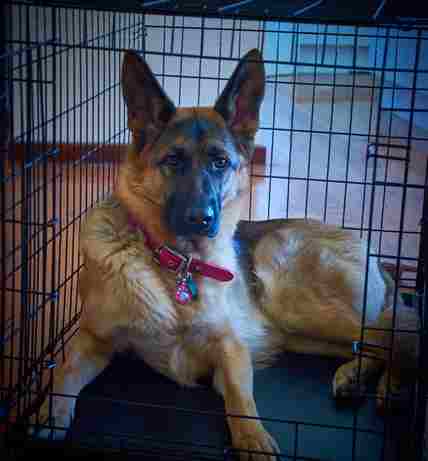Crate training is easier than most dog owners think it is. If it was hard or there was any danger to it people wouldn’t be allowed to do it on their own.
I have personally crate trained many dogs over the years and I would like to share with you some of the tips that made it easy for me to crate train faster and effectively.
The general mistake that most of the dog owners make is assuming that their dogs won’t like being in the crate. They see it as a cage so they project that idea into their dogs and start on the wrong basis.
Dogs don’t assess places based on how spacious they are but rather on experiences. That’s what we use to make the dog like being in the crate. The final goal is to have your dog choose to go in the crate.
So how do we start on the right paw? The first and most important choice you will have to make after deciding to crate train your dog will be choosing a crate.
Choosing the perfect crate
Choosing the perfect crate is the key to a successful and easy crate training. It will be your dog’s den and home so just like you give it some serious thinking before buying your house; you should do the same here.
I certainly don’t mean spend 3 months looking at crates but I am leaning toward the size of the crate and on a second degree the material it’s built with.
The material because not all dogs are alike some are more badass and stronger than others. So using a soft-side crate for an aggressive pit bull is not the brightest idea.
Choosing the right size is important so your dog can feel safe, have enough room but at the same time feel intimacy.
Buying a crate that is too small for your dog will make him uncomfortable. But also a too-large crate will make him den within the den; meaning he will use a corner to relax and the other to potty.
I strongly suggest you read this article about how big should your dog crate be. It will show you the correct way to measure your dog crate and make the right choice for the crate type you’ll need.
Even if you started crate training already and just want it to be easier; you may need to change the crate you are using because the wrong size will sure make life harder.
I strongly recommend midwest dog crates they are the best in the market. They offer crates with two doors and there are covers for the night which makes the crate training way more easy.
Knowing your dog
knowing your dog will certainly make crate training easier. As we said earlier dogs assess places based on experiences, so you would want to know if your dog has had any with crates.
Whenever I take in a rescue dog I always gather as much information about him from the shelter if there are any.
A dog that has previous bad experiences will be less motivated to cooperate with you while training.
Even new puppies are different some are more agitated than others some are more energetic.
The time a puppy can spend in the crate will be different from dog to dog. Some will need plenty of exercising before going in.
Knowing your dog’s needs will help you decide how fast you can go with the training; what kind of crate you will need and how much time it will take to make progress.
Consistency in crate training
The best way to make crate training easier is to turn it into a routine. Something that your dog will be expecting to happen.
The best way to make this a daily routine is to have the dog do the same things every day at the same time.
You need to have his bedtime set to the same time every day, his feeding time everything needs to be scheduled.
By doing the same thing every day and making the dog go to the crate using treats and praise he will get used to it.
If you have no plan and just go at it willy nilly your dog will take more time to accept the crate.
Making a crate training schedule
Making a crate training schedule is the easiest way to enforce consistency in training.
Everything has a plan and the dog knows exactly hat’s coming, this is very useful.
Making a schedule is very easy to achieve, you can read my crate training schedule article. You can find a realistic schedule for puppies and for dogs and even for working dog owners.
This is what I do and I don’t have to since there is always someone home with my dogs but still I find it very useful.
Dogs with a crate training routine are very stable, easier to train less resistant.
Making the crate great

Now, this is what makes all the difference in how your dog is going to respond to training. The faster you make the dog like the crate the faster he will accept it.
We said earlier that dogs like or dislike places based on experiences. So you want your dog to have the best time in the crate.
You can start feeding the dog his meals in the crate to get him used to it. Food, when associated with a place, is a great motivation tool.
You also want to use treats to lure your dog to the crate. Only give treats when the dog gets in.
You want to use treats with moderation so the dog does not refuse to go in if there are no treats. You can check out this dog treats guide; to help you know how much you should give per day and how to phase out.
Also, use verbal praise and toys to keep your dog happy in the crate. And you want to go gradually with the training don’t rush it.
You need to have the crate in a good position within your house. Somewhere close to the family so the dog feels you around, but also intimate.
If you do a great job making the crate a great place for your dog you won’t have to ask him to get in.
Avoiding fatal mistakes
there are some simple mistakes that could make the crate training harder. And they mostly have a direct liaison with the crate.
Using the crate for a time out
Punishing the dog by locking him in the crate for time out is the worst thing you can do. First of all, if you don’t catch your dog in the act there is no valid reason to punish him. Since that will only confuse him.
The second point is the whole idea of crate training is to make the crate a nice and safe place for the dog. If he is punished in there good luck getting him in there again.
You can’t even reprimand your dog while he is in there if he does something good reward. If he messes up just let it go.
Rushing with the crate training
If you rush your dog into the crate and close the door you will freak him out. This could make him more resistant to training.
Always introduce your dog to the crate before it’s time to actually go in there. This reduces the tension and suspicion he may have towards the crate.
Even if you see good progress take things gradually and give your dog the necessary time to get comfortable in there.
Letting the dog out when crying or whining
If your dog is whining or barking in his crate never let him out while he is still doing it.
You always want to ignore it from 15 to 30 minutes and see how he responds.
When you let him out he will know that whining is the way out. If the dog does not stop whining break his barking cycle by talking and when he stops reward and praise.
If you have to let him out make him stop before you do.
Is crate training easy for beginners?
There is no experience required to crate train a dog effectively. All you have to do is follow a program you already made.
When you are consistent and have a good routine for your dog crate training will be easy to handle.
You can follow this crate training guide with step by step so you can be aware of your progress.






